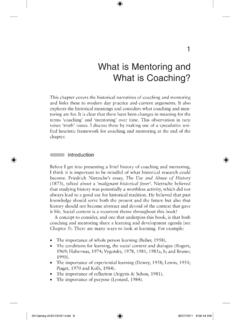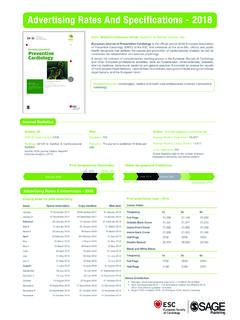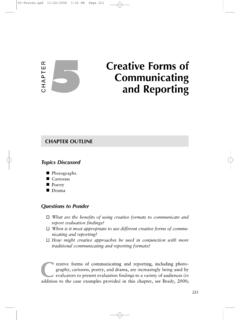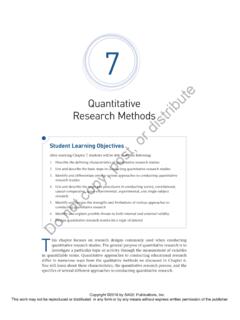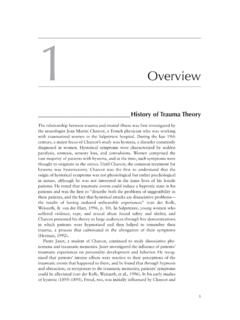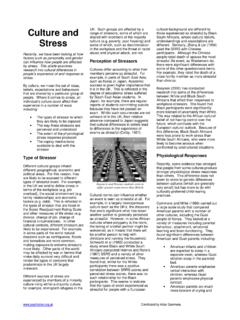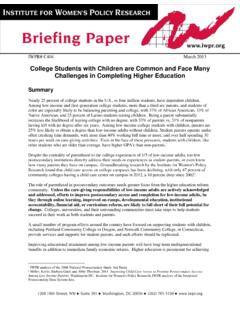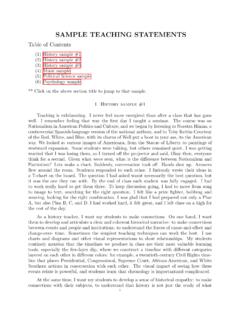Transcription of DIVERSITY AND CULTURAL ISSUES IN CLINICAL …
1 4. DIVERSITY AND CULTURAL . e ISSUES IN CLINICAL psychology . ut t rib d is The Rise of Multiculturalism Etic Versus Emic Perspective 18. in CLINICAL psychology 1 Tripartite Model of Personal Identity 19. The Diversification of the or What Constitutes a Culture? 19. Population 1 Narrow Versus Broad Definitions 20. Multiculturalism as the Fourth Force 2 Interacting CULTURAL Variables 21. Recent Professional Efforts to Emphasize t, Training Psychologists in ISSUES ISSUES of DIVERSITY and Culture 2 of DIVERSITY and Culture 22. s CULTURAL Competence 7 Educational Alternatives 22. po What Is CULTURAL Competence? 7 Measuring the Outcome of CULTURAL Self-Awareness 8 Culture-Based Training Efforts 23. Knowledge of Diverse Cultures 9 An Example of Culture Influencing Culturally Appropriate CLINICAL Skills 16 the CLINICAL Context: The Parent Child , Relationship 24. py Are We All Alike? Or All Different? 18. co THE RISE OF MULTICULTURALISM. IN CLINICAL psychology . t no The Diversification of the Population CULTURAL DIVERSITY has historically been a hallmark of the population, but in recent years, the country has become much more diverse.
2 The number of people of minority o ethnicities, as well as the proportion of the population they represent, has increased dramatically. For example, in a single decade (1990 2000), the Asian american /Pacific D. Islander population and the Latino/Latina/Hispanic population each grew by about 50%. ( Census Bureau, 2001). As of 2016, there were over 43 million immigrants in the United States, representing over 13% of the population ( Census Bureau, 2017). 1. Copyright 2020 by SAGE Publications, Inc. This work may not be reproduced or distributed in any form or by any means without express written permission of the publisher. Learning One in five schoolchildren speaks a language other than English at home (Roberts, 2004). And by 2050, about half the Objectives country's population will identify at least partially as african american , american Indian, Asian american , or Latino/Latina ( Census Bureau, 2008). Explain what it means to In certain parts of the United States, the increasing diver- e describe multiculturalism sity is especially pronounced.
3 In Miami, for example, over two ut as the fourth force in thirds of the population is Latino/Latina/Hispanic ( Census CLINICAL psychology . Bureau, 2018b). In San Francisco, individuals of Asian descent represent about one third of the population ( Census rib List professional efforts in CLINICAL psychology Bureau, 2018c). And about three quarters of the population of that demonstrate the Detroit and half the population of Washington, , are african field's current focus on american ( Census Bureau, 2018a, 2018d). t multiculturalism. CLINICAL psychologists have recognized that the people is who might seek their professional services represent a grow- Speculate how CULTURAL ing variety of CULTURAL backgrounds. As individuals and as a d competence could be profession, CLINICAL psychologists are making efforts to address demonstrated with ISSUES of culture sensitively and competently (Comas-D az, psychotherapy clients of or 2011a, 2011b, 2012; M. L. Melton, 2018; Suzuki & Wilton, various backgrounds.)
4 2016). As stated by McGoldrick, Giordano, and Garcia-Preto Compare major (2005b), We must incorporate CULTURAL acknowledgment perspectives on into our theories and into our therapies, so that clients not of t, the similarities and the dominant culture will not have to feel lost, displaced, or s differences among people. mystified (p. 4). po Define culture in the context of CLINICAL Multiculturalism as the Fourth Force . psychology . The impact of ISSUES of culture and DIVERSITY on mental health , Describe methods professionals in recent years has been so extensive that some py for training CLINICAL authors have identified multiculturalism as a defining issue of psychologists in CULTURAL the current era of psychology . For example, Pedersen (1990, ISSUES . 1999, 2008) has put forth the argument that in the evolution co of the CLINICAL /counseling field, multiculturalism represents the fourth force. With this label, multiculturalism takes its place with the three previous movements that have been broadly recognized as dominant paradigms in their respective eras: psychoanalysis as the first force, behaviorism as the t second force, and humanism/person-centered psychology as the third force (Bugental, no 1964).
5 Multiculturalism, then, stands as a major pervasive influence on the work of Web Link contemporary CLINICAL psychologists (Comas-D az & Brown, 2016; Gelso, 2011). It CULTURAL DIVERSITY represents a fundamental change of emphasis but one unlike the previous three in in the United States terms of its method of impact. Whereas behaviorism and humanism emerged as chal- o lenges to the incumbent first force of psychoanalysis, multiculturalism does not neces- sarily aim to dethrone any of the first three forces. Instead, it enhances and strengthens D. existing models by infusing them with sensitivity and awareness of how they can be best applied to individuals of various CULTURAL backgrounds (Mio, Barker-Hackett, &. Tumambing, 2006). 2 Part I Introducing CLINICAL psychology Copyright 2020 by SAGE Publications, Inc. This work may not be reproduced or distributed in any form or by any means without express written permission of the publisher. One reason CULTURAL DIVERSITY is such a powerful force in the CLINICAL and counseling fields is that it shapes the way the client under- stands the very problem for which he or she is seeking help.
6 This understanding this world . Andrea view, applied to psychological problems is e what the therapist should appreciate as he or ut she devises an approach to helping the client. Comas-D az (2011a) encourages therapists to directly assess clients' understanding of their rib own psychological problem by asking them these questions: t What do you call your problem (or is } Photo illness or distress)? CULTURAL DIVERSITY d is a hallmark of the What do you think your problem does to you? population, What do you think the natural cause of your problem is? especially or in certain Why do you think this problem has occurred? geographical areas. How has How do you think this problem should be treated? the profession of How do you want me to help you? s t, CLINICAL psychology emphasized the Who else ( , family, friends, religious leader) do you turn to for help? importance of CULTURAL DIVERSITY po Who ( , family, friends, religious leader) should be involved in decision in recent years? making about this problem?
7 (Adapted from p. 875). Recent Professional Efforts to , py Emphasize ISSUES of DIVERSITY and Culture CLINICAL psychology and related professions have addressed the issue of CULTURAL DIVERSITY co in many tangible ways. In the 1970s, efforts toward educating therapists and therapists- in-training on the importance of race and ethnicity were in their early stages. These efforts expanded through the 1980s and by the 1990s were much more widespread and comprehensive in terms of the variables, beyond ethnicity and race, around which t culture might be defined (J. E. Harris, 2012). In recent years, a plethora of efforts reflects no the increasing importance of culture within CLINICAL psychology . Journals and Books o Numerous publications on DIVERSITY and CULTURAL ISSUES in mental health have appeared in recent years. Scholarly journals in CLINICAL psychology have increasingly included D. articles on CULTURAL and DIVERSITY topics, and some psychology journals are devoted entirely to such ISSUES (Koydemir & Essau, 2015).
8 (See Table for examples.) In addi- tion, a wide variety of books now offer education and guidance to psychologists working Chapter 4 DIVERSITY and CULTURAL ISSUES in CLINICAL psychology 3. Copyright 2020 by SAGE Publications, Inc. This work may not be reproduced or distributed in any form or by any means without express written permission of the publisher. Table Scholarly Journals Relevant to DIVERSITY and Multicultural ISSUES in CLINICAL psychology Among others, these journals focus on ISSUES of culture and commonly include articles of CLINICAL relevance: e Asian american Journal of psychology Journal of Latinx psychology ut CULTURAL DIVERSITY and Ethnic Minority psychology Journal of Multicultural Counseling and Development rib Hispanic Journal of Behavioral Sciences Journal of Rural Mental Health Journal of Black psychology Psychoanalysis, Culture, and Society t is Journal of Cross- CULTURAL psychology psychology of Men and Masculinity Journal of CULTURAL DIVERSITY psychology of Sexual Orientation and Gender DIVERSITY d Journal of Gender, Culture, and Health or Among others, these journals focus on clinically relevant ISSUES and commonly feature articles emphasizing culture or DIVERSITY : CLINICAL psychology .
9 Science and Practice Journal of Counseling psychology t, Counseling Psychologist Journal of Marital and Family Therapy s po Journal of Abnormal psychology Journal of Mental Health Counseling Journal of CLINICAL psychology Professional psychology : Research and Practice Journal of Consulting and CLINICAL psychology Psychotherapy: Theory, Research, Practice, Training , py with diverse populations. Some of these books focus on a single population, such as Working With Asian Americans (E. Lee, 1997), Psychotherapy With Women (Mirkin, co Suyemoto, & Okun, 2005), or Counseling Muslims (Ahmed & Amer, 2012), whereas others compile chapters on many different populations, such as Ethnicity and Family Therapy (McGoldrick, Giordano, & Garcia-Preto, 2005a) or Counseling Diverse Popu- lations (Atkinson & Hackett, 2003). Collectively, these publications represent a wealth t of CULTURAL knowledge for contemporary CLINICAL psychologists, and their increasing no presence acknowledges the importance of the topic.
10 Emergence of american o Psychological Association Divisions D. Within the american Psychological Association, new divisions arise when a subset of members recognizes a need to study or examine a specific topic in depth. Among the divisions created most recently, many focus on DIVERSITY or CULTURAL ISSUES , including the following: 4 Part I Introducing CLINICAL psychology Copyright 2020 by SAGE Publications, Inc. This work may not be reproduced or distributed in any form or by any means without express written permission of the publisher. Division 35 Society for the psychology of Women Division 36 psychology of Religion Division 44 Society for the Psychological Study of Lesbian, Gay, and Bisexual ISSUES e Division 45 Society for the Study of Ethnic Minority ISSUES ut Division 51 Society for the Psychological Study of Men and Masculinity rib american Psychological Association Ethical Code Numerous specific standards and principles in the most recent edition of the american Psychological Association (2002) ethical code compel psychologists to work with CULTURAL t sensitivity and competence.
